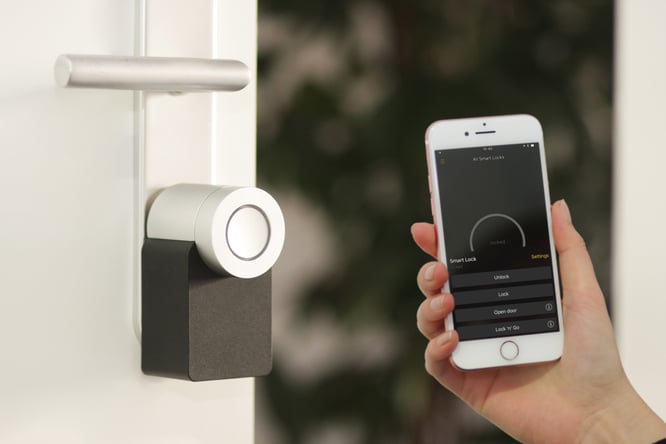Business-to-business (B2B) IoT implementations are frequently used internally to optimize processes for smart manufacturing environments, smart inventory systems, and inside smart offices; but digitally mature companies are using IoT to create connected products and services that can activate an entirely new set of sell-able digital services.
The affordability of sensors, data storage, and cloud computing has driven the exponential production of smart, connected products for consumers. However, there is a great opportunity for businesses serving other businesses to benefit from creating and supporting connected products.

IoT Connected Products
It has been predicted that 90 percent of consumers own at least one connected product in the home. Smart toothbrushes, garage doors, lightbulbs, etc. are designed with sensors and a built-in method for connecting to the internet. The data from the product is returned via a mobile app, a web app, or an existing platform (i.e. Philips Hue, Amazon’s Alexa, Google Home). Creating connected products requires the same structure. To build IoT into products, enterprises and manufacturers must do the following:
1. Build in sensors or tap into a product’s existing sensor
2. Coordinate a method for connecting those sensors to a network
3. Begin using a platform to gather the data
It’s not surprising that the number of connected devices continues to rise. Consumers now expect the benefits of connected products and real-time data from IoT, as do businesses serving other businesses. Gartner estimates that 5.8 billion IoT connected devices will exist for enterprise and automotive alone by 2020. That is because connected products provide access to extremely valuable IoT data for enterprises. Data from products helps enterprises identify new ways to serve customers, continuously improve their product based on customer usage, and find new revenue opportunities.
Revenue-Generating Business Models for Connected Products
Several organizations have provided great blueprints for generating revenue by implementing IoT into the product lineup. For instance, consumers can purchase one connected doorbell camera, but they are also presented with the opportunity to purchase a subscription to store and view footage from the doorbell camera. This business model requires the manufacturer to sell only one item but begin an ongoing relationship with its customers. That manufacturer can sell its customers access to that product’s information for a lifetime. Outside of the thousands of consumer brands similar to this example, businesses serving businesses (B2Bs) have also been at work identifying new business models, revenue streams, and audiences through the use of IoT. Here are a few common business opportunities that IoT can enable:
- IoT-enabled product-as-a-service - In this model, enterprises can sell complete solutions, which includes the management of maintenance, repair, and replacement of products that customers may not be interested in owning outright (i.e. espresso as-a-service or air as-a-service).
- Tracking and monitoring - An IoT solution can provide a constant stream of real-time data from connected products or a supply chain. This information can provide an enterprise and its customers with an opportunity for automated inventory replenishment, parts replacement, predictive maintenance, or remote industrial equipment monitoring.
- Digital subscription services - Enterprises can use an IoT application to access information about products to sell maintenance or compliance services. One of the best examples of this is condition-based maintenance or remote monitoring. If a piece of equipment is connected to an IoT platform, it can trigger an alert when certain conditions indicate a repair is needed.

What Are Some Examples of How Enterprises Use IoT To Expand Services?
Anything-as-a-Service
- As more startups emerge and organizations become leaner, the as-a-service market continues to grow. It has become more cost-efficient to purchase a complete solution instead of owning and maintaining certain products. For instance, instead of purchasing light fixtures and maintaining each light bulb in an office, an enterprise may opt to use lighting-as-a-service. According to Acquire Market Research, the lighting-as-a-service market, which includes major manufacturers like Cree, Phillips, and GE, has grown from $50 million in 2014 to $140 million in 2019. Outsourcing solutions to help businesses simplify operations is certainly not a new concept, but IoT makes it more available for more industries. The integration of IoT also makes usage data much more accurate.
- Even if your organization doesn’t sell lighting, there may be a viable as-a-service option that an IoT solution can help provide. Although the maintenance, repair, and replacement of a product become the responsibility of the manufacturer, the product-as-a-service option is not only beneficial to buyers. Because the manufacturer owns the connected product, it can capture data about how the product was used in the market. Before the emergence of IoT, manufacturers and product managers rarely received much information about how products in the field performed until they failed or received a warranty claim. IoT enables product manufacturers to receive valuable data about the conditions that spark errors or failure. This data can also serve as a great R&D tool to help enterprises extend service life and make better products in the future.

Cold-Chain Monitoring With IoT
- Cold chain monitoring with IoT, or the intelligent monitoring of a temperature-controlled supply chain, has the potential to benefit chemical, food, logistics, pharmaceuticals, and other industries. Stakeholders in the production, shipping, and receiving ends of the supply chain need to be aware of where assets are located, the temperature, and the integrity of those assets at all times. According to Markets and Markets the cold chain monitoring market is expected to grow from $3.8 billion in 2018 to $6.46 billion by 2023.
- Implementing an IoT solution for cold chain monitoring presents a business opportunity by providing access to real-time information about a product, shipment, or part of a supply chain. This opportunity can be realized for many different supply chains to help suppliers improve efficiency, maintain the integrity of shipments, monitor activity, prevent theft or loss, and prepare alternative routes or plans in the event of an emergency.
Subscription Services
- The Internet of Things has created unique opportunities for businesses to create ongoing relationships and partnerships with customers in place of single transactions. Enterprises can create a new set of services to which customers can subscribe related to real-time product data.
- If you are an OEM and would like to offer additional services to customers to promote OEE and data about uptime, tapping into machine information using data from sensors can help your organization create a condition-based maintenance offering. Verizon, for example, can now offer its OEM customers a service that enables them to switch from preventative maintenance to condition-based maintenance using an application built on the Losant IoT platform. OEMs who choose Verizon's IoT solution can integrate CBM and service-based solutions into their supply chains.
Getting Started With Connected Products and IoT
As discussed, there are several ways enterprises can offer their customers additional services using IoT. The first step in our guide, Business Innovation, and Expansion with Industrial IoT, is to determine how you can solve a problem for your customers and add value. If you would like to learn more about strategic partners who can help you realize the IoT vision, speak with one of our IoT experts at Losant. We’ve helped several Fortune 500 clients get on the positive side of their IoT investment.
